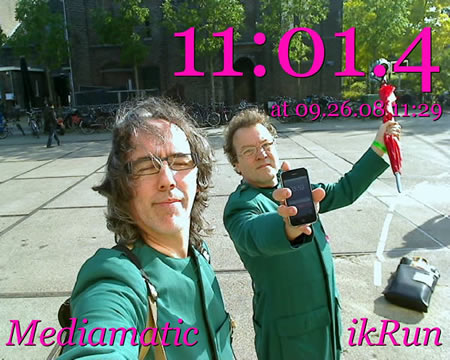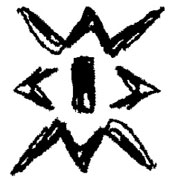This SoundBlog page was adopted by the Werkgroep Interactieve Media, based in Hoogersmilde (the Netherlands), on oct. 13, 2008 ... [ ? ]
The Right to be Slow [embedded artists]
october 02, 2008.
As part of Rob
van Kranenburg's selection of twenty-five artists 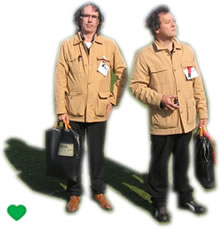 invited to provide their idiosyncratic views on this major dutch digital-media-mega
event, for three full days (sept. 24th, 25th and 26th) ookoi
joined the "heads of business, government leaders, marketers, designers,
producers, investors ..." that were heading for the 3rd
PICNIC on the Westergasfabriekterrrein
in Amsterdam. There they indulged in the miracles and wonders of a myriad
of "cutting-edge products and services at the intersection of media,
technology, arts and entertainment".
invited to provide their idiosyncratic views on this major dutch digital-media-mega
event, for three full days (sept. 24th, 25th and 26th) ookoi
joined the "heads of business, government leaders, marketers, designers,
producers, investors ..." that were heading for the 3rd
PICNIC on the Westergasfabriekterrrein
in Amsterdam. There they indulged in the miracles and wonders of a myriad
of "cutting-edge products and services at the intersection of media,
technology, arts and entertainment".
They, us, altogether ... called and asked to "create the future"
...
And we went. "Net zo makkelijk," one says in dutch.
But we were well aware of what we were: embedded
artists.
That is to say: the right people, and in the right place.
PICNIC, " Amsterdam's annual digital schmoozefest " ( * ), is an initiative of 'crossmedia company' Media Republic and De Waag Society. Just like many of those responsible for the basic structure, the protocols and the original philosophy behind what became the internet had their roots in the 1960s hippie and psychedelic movement, the origin of dutch pioneering digital and e-culture institutions Mediamatic and De Waag can be traced back, via 1990s initiatives like Hacktic and De Digitale Stad, to the dutch 'autonomous' squatting and DIY culture of the 1980s. Which therefore, and that is rather curious, connects the present to the SoundBlog's previous entry ...
PICNIC08 was fast-paced.
This was well-illustrated by one of the several applications - all of them refreshingly playful, like a vibrating sofa and a make-a-new-friend-get-a-free-drink voucher printer - powered by Mediamatic's pet-technology: RFID (see also the earlier SB-entry Rags 'n' Riches). The applications were installed at several of the PICNIC locations, and were activated by the tags that were handed out at the registration desk, and linked to your personal profile on the picnicnetwork web site.
The application I mean was called ikRun.
What you were asked to do was simple: run as fast as possible from Virtueel
Platform's E-Art Media Dome along the Gosschalklaan
to the Gashouder ... To clock your 'race', you activated a timer
by placing the RFID-tag
on the module (see picture) outside the Dome. Upon arrival at
the Gashouder, you then stopped the timer by posing the (same)
tag on the finish-module over there. 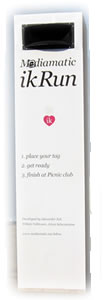 Accompanied
by heartfelt cheers or disdainful laughter, a picture was taken and automatically
added to your picnicnetwork profile ... According to Google maps, the distance
from start to finish is some 260 meters (850 feet).
Accompanied
by heartfelt cheers or disdainful laughter, a picture was taken and automatically
added to your picnicnetwork profile ... According to Google maps, the distance
from start to finish is some 260 meters (850 feet).
PICNIC participants loved it.
It was a popular recreation; or was it another challenge to be met? Already
on the very first day we witnessed new young media workers that with evident
athletic ambition sprinted their hearts out. But this was a smart bunch,
and competition is tough. It therefore did not come as a surprise that not
much later we saw this thirty-something marketer activate the ikRun
clock only to race off fast as lightning on a light-weight bike ... Better
still was the following sample of collaborative creativity, as
demonstrated by a couple of young-ish start-uppers.
Let us call them
Abelard and Eloise ...
Abelard had
a second tag made at registration, also linked to his (the same) profile. He gave it to Eloise
who then took it over with her
to the finish. Once arrived there, Eloise used her handy to call Abelard
who had stayed at the start. Abelard then activated the timer with
his tag, only for Eloise to asap bring it to a grinding halt again with the second tag ...
"A la guerre comme à la guerre," one says in french. We decided to take it easy. And we made a new number ... :
But how slow could one get?
Not very, as a matter of fact. Which was sort of intriguing. I will try to indicate why, as this should be seen in relation to the many issues related to the 'silent' but 'large-scale' introduction of the RFID-technology, of 'low-end' and 'ambient' computing into everyday life, enabling the massive 'tracking' of all and everyone's moves in an 'internet of things'. All of us are being tracked, and we know it. But then shouldn't we also - at least be able to somehow - control that tracking?
In our first attempt at establishing a _l o n
g_ ikRun we activated the timer with our
RFID-tag around lunchtime on wednesday september 24th.
Going around our planned PICNIC-business for
that day, we only passed at the Gashouder again for the first time
after activation towards the end of that day, some five or six
hours later. ( ** )
But when we came there and tried to stop the clock that - we were sure
of it - for us was still running ... nothing happened.
Can you imagine our confusion? How come? Where were we? Why didn't we show up on the screen among those that had 'just arrived'? It took a while before we realized that we had been 'kicked' from the system. We had disappeared from the base. We did no longer exist ... Eventually we were told that the ikRun had been programmed such as to 'drop' ikRunners that did not 'finish' within 20 minutes. And there was nothing we could do about it ... So, you see, the ikRun-application in a way deprived PICNIC- participants from one of their fundamental rights: the right to be slow ...
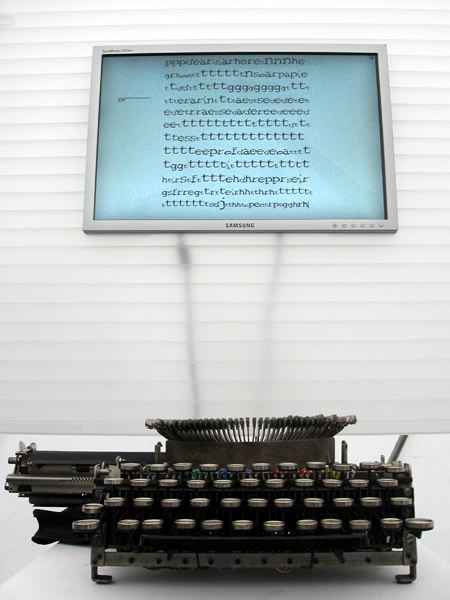 |
One of the e-art objects on show in Virtueel Platform's Media Dome: Virtueel, by Jelte van Abbema of MU (Eindhoven). A Remington typewriter is linked to a digital screen, and made 'touch sensitive'. If you strike the keys softly, letters are small and thin; when you strike them hard, the letters come out big and bold; the letters in saved documents will slowly fade out ... |
Of course there were laptops everywhere, on each and every one of PICNIC's locations, spread across the Westergasfabriek Culture Park, most of which from early morning until early evening were (wo)manned by lab-bing, lobby-ing, conferenc-ing and network-ing corporate heroes, sent by and representing a great many small and large, national and international, companies, for which in one way or another digital media and technologies are at the heart of their business. Some came looking for investors. Some came looking for new ideas. Some came for both. All came with at least as many handies as they came with people.
The iPhone
proved a most frequent specimen among the divers breed of hi-tech handheld
communication devices that I saw being used at PICNIC.
Some of you will know that I've got a pretty smart handy myself: a titanium
black LG
Shine with a custom inscription on its back, that says: "... toute
la vie ...". When I accidentally dropped it on the floor, inside the
Virtueel
Platform's white Media Dome, I overheard one lady who had seen
this happen smile to a friend: "I bet he's doing it on purpose. If it
breaks, that'll give him an excuse to buy an iPhone ..." Though this
would make a marvelous hook for a series of iPhone ads, to be honest,
I am not really interested in obtaining an iPhone to replace my phone.
iPhone
proved a most frequent specimen among the divers breed of hi-tech handheld
communication devices that I saw being used at PICNIC.
Some of you will know that I've got a pretty smart handy myself: a titanium
black LG
Shine with a custom inscription on its back, that says: "... toute
la vie ...". When I accidentally dropped it on the floor, inside the
Virtueel
Platform's white Media Dome, I overheard one lady who had seen
this happen smile to a friend: "I bet he's doing it on purpose. If it
breaks, that'll give him an excuse to buy an iPhone ..." Though this
would make a marvelous hook for a series of iPhone ads, to be honest,
I am not really interested in obtaining an iPhone to replace my phone.
What does interest and impress me though,
both with the iPhone and the iPod Touch, is the user-interface:
a multi-touch screen combined with a built-in accelerometer. I toyed with
that for a while ( *** ) and was immediately won over.
It was a bit like the at-first-sight recognition of the correctness
of the solution to a problem, as I know it from doing math: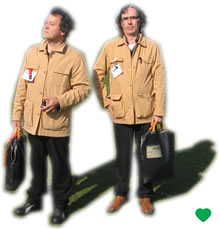 long before having sorted out the many details, sometimes one senses with
great certainty that a particular solution can not be but the right
one. And even though in this case it may not be completely clear what precisely
the problem was, the iPhone's interface convinced as its solution
from the very moment I first laid my hands on it. Undoubtedly this is how
soon enough a lot - maybe most - of man/machine interfacing will be done:
no more buttons, no more trackpads or joysticks, no more mice ... just one's
fingers and a screen on small handheld devices that in ever more subtle
ways will respond to the way in which they are held, to the way
in which you move them; that will learn to react to - only - your
voice, and to the where's and what's of your current location in
view of predicted intentions derived from (one of) your histor(y)(ies) ...
Wirelessly connected 24/7 to the - or probably rather: an - (inter)net
of data, things and applications.
long before having sorted out the many details, sometimes one senses with
great certainty that a particular solution can not be but the right
one. And even though in this case it may not be completely clear what precisely
the problem was, the iPhone's interface convinced as its solution
from the very moment I first laid my hands on it. Undoubtedly this is how
soon enough a lot - maybe most - of man/machine interfacing will be done:
no more buttons, no more trackpads or joysticks, no more mice ... just one's
fingers and a screen on small handheld devices that in ever more subtle
ways will respond to the way in which they are held, to the way
in which you move them; that will learn to react to - only - your
voice, and to the where's and what's of your current location in
view of predicted intentions derived from (one of) your histor(y)(ies) ...
Wirelessly connected 24/7 to the - or probably rather: an - (inter)net
of data, things and applications.
You will have heard it before, but let me say it again: for all practical purposes personal computers as we know them will soon become superfluous ... And notwithstanding the many looming dangers this may entail, I could not but marvel at the thought: despite the dazzling gap that separates my very first 'go' at computing with a pack of FORTRAN punchcards that were fed into an IBM Mainframe in the 1970s ( **** ) from the writing of this entry on a wirelessly connected MacBook, in fact 'we ain't seen nothing yet' ...
PICNIC's keynote- and other lectures took place in the Zuiveringshal West, which had been transformed into a large theatre. Its 'green' ("is the new black") and sober but nevertheless 'monumental' decoration undeniably showed Speer-ish qualities. This was at least partly due to Levi van Veluw's (one of this year's PICNIC featured - as opposed to embedded - artists) 4 x 5 meters grand self-portraits that were adorning the walls.
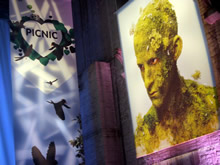 |
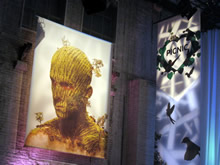 |
While during the conference's kick off, with one or two feeble
attempts by PICNIC co-founders Marleen
Stikker and Bas
Verhart to have the audience join in a massive 'do-you-feel-allright'
and 'are-you-ready-for-PICNIC' cheer, the stage up front was taken
by Charles
Leadbeater lecturing on 'The Power of Mass Creativity', I sat playing
Koi
Pond on the iPhone. Koi Pond ('koi'
is japanese for 'carp') is nothing much, really.  There's
just a bunch of colorful fish animations swimming around in a virtual pond.
Remarkably though, the iPhone's screen acts as the water's surface. Tapping
the screen or dragging your finger around will cause ripples and waves that
scare the koi away. If you shake the iPhone, you release pellets
of food, and your fish will re-appear and eat. Keeping your finger motionless
on the screen will induce them to surface, and 'nibble' your finger ...
Surprising and entertaining ... But what precisely is it, this whatchamacallit,
this ... thing ... ? It hardly can be called a game. It has
no purpose or goal, whatsoever. Nothing to win, just time to lose. No
beginning, no end ... I actually find that it most resembles a snow
globe, probably because of the shaking. What's interesting
about this, is that apparently I tend to think about the 'thing' as of an
object ...
There's
just a bunch of colorful fish animations swimming around in a virtual pond.
Remarkably though, the iPhone's screen acts as the water's surface. Tapping
the screen or dragging your finger around will cause ripples and waves that
scare the koi away. If you shake the iPhone, you release pellets
of food, and your fish will re-appear and eat. Keeping your finger motionless
on the screen will induce them to surface, and 'nibble' your finger ...
Surprising and entertaining ... But what precisely is it, this whatchamacallit,
this ... thing ... ? It hardly can be called a game. It has
no purpose or goal, whatsoever. Nothing to win, just time to lose. No
beginning, no end ... I actually find that it most resembles a snow
globe, probably because of the shaking. What's interesting
about this, is that apparently I tend to think about the 'thing' as of an
object ...
If nothing else, this does hint as to one among possible directions for the development of digital 'game-like things' as an art form, which, btw, has become a recent focus for Stichting WIM's R&D department. ( ***** ) Of course in this WIM does not stand alone. On friday september 26th PICNIC saw the attribution of the Ding! Prize for artistic game development, the result of an open call (though on a very short notice) that was issued by the Virtueel Platform, the Fonds BKVB and the Stifo for 'concepts to stimulate the development of games with an artistic angle'. The Ding! Prize went to the Stedelijk Museum and Submarine Channel, for 'A Split Second', a joint proposal for the development of an autonomous game involving 'arbitrary moments of decision'.
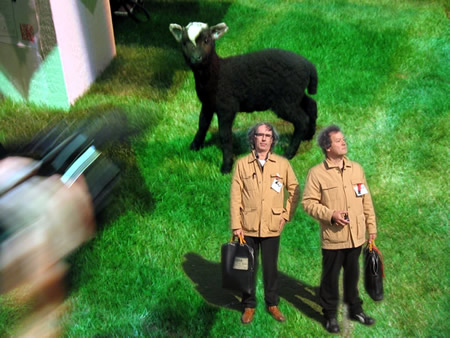
Collaborative creativity was this year's PICNIC's main theme. Or maybe it was rather about 'mass collaboration & participation', as epitomized by "The Sheepmarket", a work by Aaron Koblin, the most visible among PICNIC's featured artists. "The Sheepmarket" consists in a collection of 10.000 drawings of 'left-looking sheep', made by workers on the Amazon Mechanical Turk web site, an online 'marketplace for work'. Koblin's 'Turks' got paid 2 american dollar cents for each finished - and accepted - drawing of a sheep that they submitted.
There is of course a substantial difference between a work that is collectively
created by a great many 'creators', and a work that is being done using
the input of a lot of different individuals. We all believe firmly
in the second option, where one person or a relatively small team directs,
shifts through, evaluates and then uses (or not!) the input and/or productive
work of lots of contributors. Mainly of course because this is the way substantial
'production' has always been organized. It is the way the Egyptians built
their pyramids, it is how Eiffel had his tower made, it's how New York erected
the Empire State Building and it is how physicists gave us the LHC.
They all use 'Mechanical Turks'. What's new, is that the internet
and the ensuing 'global connectivity' potentially gives us access to 'groups
of Mechanical Turks' defined by whatever imaginable criteria, including
their locality or not. That is why and how photographer Spencer
Tunick succeeds in bringing together up to several thousands of individuals
at a precise moment in a precise place, willing to, all together, take of
their clothes and pose naked for one of his pictures. What is also
new, is that the web and the digital tools currently available enable different
sorts of '(auto-)organization' of (very) large groups of individuals for
productive work in other than 'physical' domains, using (mainly) volunteers,
on a scale that is unprecedented in human history. Think for example of
the writing, correcting, verifying and moderating of texts as it is done
for Wikipedia. Or the coding and testing for open source software projects.
One of the more recent examples that was among those presented at PICNIC
is filmmaker Matt Hanson's A
Swarm of Angels, an attempt at collaborative creation of an 'open source'
feature film.
I think that on the other hand the first option - the idea(l) of a truly
collective, non-hierarchically organized 'creation', with equal responsibility
for all those involved - will almost always turn out to be un-work-able.
It is interesting to observe that collaborative projects starting out on
the basis of strictly equal responsibility over time often are seen to settle
'naturally' in some de facto hierarchical structure. As e.g. Charles
Leadbeater observed in his PICNIC keynote lecture
on wednesday: whereas many of the Wikipedia pages have been 'edited' over
time by a substantial number of individuals, closer inspection learns that
very often almost all of these edits actually were made by only a very small
subgroup ...
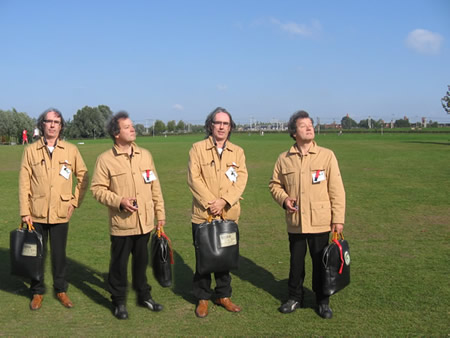
Which finally brings us to music. Because despite the remarks above, we know very well the power of collective non-hierarchical creativity. It, for example, is at the heart of free improvisation, where a collective of musicians with equal but balanced input auto-organizes to create a meaningful and dynamic musical process. We also know that in a such improvisation 'size matters': when the number of players increases we soon come to a point - in practice that seems to be with around six players - where in order for the collaboration to continue to be successful some form of prior organization appears to be needed. And when the number of participants in the improvisation increases even further - as soon as there is more than ten, twelve - the need for an even stricter organization is soon felt: it is then that one asks for a 'conductor' ...
A such view of music as a metaphor for our ability to (self-)organize, and that of the conductor's leading of an orchestra for a management leading a business, was brought to the fore at this year's PICNIC by Israeli conductor Itay Talgam, who exploits these ideas in the Maestro program, a series 'learning from music' workshops for companies and other organizations ... He was one of the speakers, and his talk 'Conducting Creativity' - late wednesday afternoon - must have been among the more interesting and thought-provoking of PICNIC08. Many told us so, for example some of the other embedded artists that had been there ... You can see a couple of minutes of the talk in the short uTube (shot by ulrikerenate) to the right. But sorry to say that we actually missed Itay's talk ... At the time we were embedded elsewhere ...
Now, would you eat me if you could?
notes __ ::
(*) Which is how the Amsterdam
Weekly  described the
event (volume 5, issue 37, page 7: "The 'It' Girl") [
^ ]
described the
event (volume 5, issue 37, page 7: "The 'It' Girl") [
^ ]
(**) We indeed also considered 'arriving' on friday, the conference's
final day, but decided against it. It would have been 'unfair', as meanwhile we would have
'crossed' the finish several times without actually 'finishing' ...
[ ^ ]
(***) ookoi has a non-zero iPhone factor.
[ ^ ]
(****) ... via the several weeks long lasting calculations
on fractal images coded in BASIC
on my 8-bit Commodore
64 in the early 1980s, and my first resplendently blinking HTML
pages made on a Paris university's SUN-workstation
in the mid 1990s ... [ ^ ]
(*****) The 'Stiching WIM'
(that is: Werkgroep Interactieve Media) provides much of the ideological
and all of the administrative context for ookoi's activities ...
[ ^ ]
tags: PICNIC08, Amsterdam, ookoi, new media, RFID, sheep
# .277.
smub.it | del.icio.us | Digg it! | reddit | StumbleUpon
comments for The Right to be Slow ::
|
Comments are disabled |
Read about the ookoi elsewhere:
ANNUAL, 1, december 2023 (Korm Plastics) - Green-tainted hyperbole, quailish quirks and summer-flies. The inscrutable genius of the ookoi.
eContact! 21.2, july 2023 - Towards an Unhearable Music. Conceptualism in the ookoi's art.
Gonzo #88, september/october 2008 - Zelfcomponerende Klankstukken
Read about the ookoi and Raudio and Stduio on the SoundBlog:
(2024, december 24) - The « ookoide » (Awesome Foursomes (xxii) - No. 131)
(2024, september 10) - Home is my Rome (Awesome Foursomes (xix, xxi) - No. 506, 507)
(2024, june 17) - Long live ookoi! (Leve ookoi!): a b.ookoipera / een tehoorspel
(2024, march 04+) - The « ot-o ki do ki » (Awesome Foursomes (xviii) - No. 624)
(2023, december 31) - d.ookoi writes b.ookoi (ii) - A Year in the Rear (2023)
(2023, december 16+) - Awesome Foursomes (xi) - No. 178
(2023, december 16+) - Awesome Foursomes (x) - No. 789
(2023, december 16+) - Awesome Foursomes (ix) - No. 329
(2023, august 20) - Three days of residency at Les Ateliers Claus, Brussels
(2022, april 25) - Awesome Foursomes (viii) - No. 664
(2022, march 31) - Awesome Foursomes (vii) - No. 138
(2022, february 20) - Awesome Foursomes (vi) - No. 419
(2021, november 01) - Awesome Foursomes (v) - No. 954
(2021, august 20) - Awesome Foursomes (iv) - No. 793
(2021, july 18) - Awesome Foursomes (iii) - No. 562
(2021, july 09) - Awesome Foursomes (ii)- No. 284
(2021, june 21) - Awesome Foursomes (i) - No. 019
(2021, may 31) - d.ookoi writes b.ookoi (i)
(2020, january 26) - STDUIO Arti: aLife @Hal-fIve
(2020, january 25) - STDUIO Arti: The LⒶst Weekend
(2019, march 03) - ookoi 2.0: the remake of a spect[r]al b[r]and
(2017, april 12) - 1024
(2015, march 07) - The men once in green are now writing a book!
(2014, may 09) - You are NOT Hier!
(2013, july 03) - How to keep devils away
(2013, may 06) - Next Numbr!
(2012, june 24) - Ninja Fruit Plus Instruments
(2012, may 06) - Y.3 = Yltra !
(2012, may 06) - Our final gig / Ons laatste optreden
(2010, may 23) - 'Raise the trumpet, sound the drum'
(2010, april 02) - [Second Life and WudyWudy]
(2010, january 05) - ookoi: onderood
(2009, november 17) - Soli Deo Gloria !
(2009, october 10) - Project Icarus OST
(2009, august 24) - ookoi ShakeNRoll
(2009, july 18) - Pure . Reactive . Music . Hack Day
(2009, april 07) - "Blood and Bottom" (Raudi0GaGa)
(2009, february 21) - Insular arithmetic (ookoi toont)
(2009, january 31) - A glimpse of Heesbeen
(2009, january 15) - Rien à voir
(2008, october 02) - The right to be slow
(2008, june 06) - Raudio Graffiti: almost live !
(2008, february 24) - The Great Washing
(2007, december 04) - I'm an island
(2007, november 20) - Live Beyond the Paradiso, Amsterdam
(2007, september 04) - leve ookoi! (3)
(2007, august 22) - leve ookoi! (2)
(2007, august 12) - leve ookoi! (1)
(2007, april 12) - Back to Berlin [Raudio 11/15]
(2007, march 24) - Vicky, Killers and Avatars
(2007, february 15) - Every presentation is a premiere
(2007, january 25) - 1024 Waarden, by ookoi
(2007, january 19) - Preparations for a Second Life
(2006, november 05) - Cellarlar Heroes
(2006, october 20) - Funky shit
(2006, august 14) - placard : la générale
(2006, july 07) - de-'tails of lite house keeping'
(2006, may 06) - jam karet?
(2006, april 04) - 100+ new (r)audio philes ... [3] [Raudio 07]
(2006, march 20) - raudio @cosman's
(2006, march 12) - 100+ new (r)audio philes ... [2] [Raudio 07]
(2006, march 03) - 100+ new (r)audio philes ... [1] [Raudio 07]
(2005, october 12) - Raudio #06 [Raudio 06]
(2005, september 25) - 0 OK, 0:1, life on ze road
(2005, july 31) - Outside - Inside Paradiso
(2005, june 18) - Sand-Y da-Y #5-7 [Raudio 05]
(2005, june 05) - Sand-Y :: da-Y #04 - da birds
(2005, may 26-24) - Sand-Y :: da-Y #03, #02, #01 - Crew cut ; "The truth is out here" ; ::
(2005, may 14) - 9 Beet Stretch [Raudio Special]
(2005, march 31) - Raudio #04 :: "GespRek 1982-2005" [Raudio 04]
(2005, february 10) - raudio #3 (drie/three) [Raudio 03]
(2004, december 08) - pure sound [Raudio 02]
(2004, november 24) - other, and good news! [Raudio 01]
(2004, october 10) - raudio launched
(2004, september 24) - made in ameland
(2004, june 09) - boyzz buzz # listen!global corpus
(2004, may 20-31) - >∞-îl_o_tré
Read some of the ookoi's papers in pdf:
(2014) - Localized Sounds, Sounding Locations.
Presented at the International Symposium "Locative Media and Sound Art", Kortrijk (be)
(2007) - ookoi - Uptime Publishing Demonstration. (With Jay Needham.)
ookoi - The works:
(2015—now) :: writing b.ookoi: pick a number!
(2017) Weekly, 10'24" :: ookoi dooki podcast
(2014) HIER - iPhone app, 4 track album of localized Future Popp
(2013) Y ¬ Y.1024 (HTML5 web app)
(2013) Wandelzand - iPhone app, soundwalk for the Dutch isle of Ameland
(2012) Palm Top Theatre V2
(2010) WudyWudy, machina movie, filmed in Second Life by Evo Szuyuan (trailer)
(2009) ookoi_@_E@rport, Amsterdam - channel 19 of the RAUDIO IIIII streaming audio art iThing app
(2009) ShakeNRoll, Project Icarus OST - scenes for the RJDJ reactive music iPhone platform
(2009) iRingg®, iPhone ringtones
(2009) 2525 (video)
(2008) L'Ecoute - public space screen video
(2008) Jam Karet I & Jam Karet IV - pocket movies
(2007) Live beyond the Paradiso (USB-stick data-dump)
(2007) Leve ookoi! - channel 16 of the RAUDIO IIIII streaming audio art iThing app
(2007) 1024 (DVD)
(2007) 1024 Waarden - flash animation
(2006) "Roam Stroam" - channel 12 of the RAUDIO IIIII streaming audio art iThing app
(2006) Tijdrekken - flash animation
(2005) Sand-Y (Zandoog) - channel 7 of the RAUDIO IIIII streaming audio art iThing app
(2004) Muziektafel-Tafelmuziek (CD)
...
(1980) Signs and Symptoms
